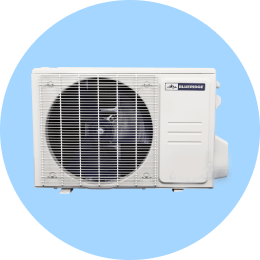
What exactly makes up a mini-split AC unit? Whether you’re considering installing one or just curious about how they work, let’s dive into the heart of these heating and cooling marvels and learn more about why they’ve become such a popular choice for businesses and homeowners everywhere.
KEY TAKEAWAYS
- Mini-split AC units consist of indoor and outdoor components connected by refrigerant lines. Most mini-split systems provide cooling and heating.
- Though purchasing an AC-only mini-split unit may still be possible, most people find heat pump mini-splits a popular choice for year-round comfort.
- Proper installation and maintenance are essential for maximizing the lifespan and performance of mini-split AC units.
What is a Mini Split AC Unit?
Mini-split AC units, often called “mini-splits” or “mini-split systems,” are versatile and compact air conditioning and heating systems that provide individual room or “zone” climate control without the need for ducts.

The recent surge in interest in mini–splits can be attributed to various factors, with their superior energy efficiency and easy, DIY-friendly installation at the forefront.
These air conditioning systems allow homeowners–even those with older properties or those working with limited space–to implement a modern heating and cooling solution without the extensive ductwork required of traditional central forced air systems.
Not only that, but a ductless mini-split air conditioning system also allows a business or homeowner to program a specific temperature for each room or zone, offering a customized comfort solution throughout any space.
The underlying technology allowing these systems to heat and cool is the “inverter compressor,” which can reverse its operation, allowing it to transfer heat into and out of your indoor space, depending on your needs.

The Anatomy of Mini-Split Air Conditioners
One of the most significant differences between ductless mini-split systems and the traditional HVAC systems most of us in the United States are familiar with is that these innovative and energy-efficient heating and air conditioning systems pack a big energy punch despite being small in design.

The Outdoor Unit: The Heart of the System
This unit is installed outside of a home or building. It contains the compressor, condenser coil, and a fan.
The compressor pressurizes the refrigerant, and the condenser coil releases heat from the refrigerant into the outdoor air. The fan helps dissipate this heat.

The Indoor Unit: Distributing Comfort
This unit is installed outside of a home or building. It contains the compressor, condenser coil, and a fan.
The compressor pressurizes the refrigerant, and the condenser coil releases heat from the refrigerant into the outdoor air. The fan helps dissipate this heat.

The Connecting Components: Refrigerant and Electrical Lines
The indoor and outdoor units work together seamlessly, thanks to the refrigerant and electrical lines running between them.
These lines have two main purposes:
- Refrigerant Lines: Also called a line set, these lines transport the refrigerant back and forth between the outdoor and indoor units, ensuring a continuous flow of coolant. This is pivotal for the efficient heating and cooling of the indoor space.
- Electrical Lines: These lines also enable communication between the indoor and outdoor units. The indoor and outdoor units must work together cohesively in a mini-split system.
When you adjust the temperature settings on the indoor unit, the electrical lines transmit this information to the outdoor unit, which adjusts its operation accordingly to meet the set requirements.
Insulation: Protect Your Connections
Proper insulation is important for the refrigerant and electrical lines to operate correctly.
The refrigerant lines between the indoor and outdoor units should be adequately insulated to prevent energy loss and ensure the system runs optimally.
Proper insulation will go a long way to ensure the refrigerant’s temperature is where it should be and safeguard against potential damage from external factors like weather conditions or physical wear and tear.
Insulation optimizes performance and contributes to the system’s longevity and energy efficiency. It ensures that everything is performing at its peak while minimizing operational costs.


Understanding the meticulous design and function of a ductless mini-split system will provide potential buyers the clarity they need before purchasing one.
Each ductless air conditioning system component is engineered to deliver unmatched climate control and superior comfort, regardless of the installation location and outside environment.

AC-Only vs. Heat Pump Mini-Splits
Mini-split systems come in various configurations, primarily divided into two main categories: AC-only and heat pump systems.
These air conditioning systems are designed to meet specific user needs, and your choice will have much to do with your unique heating and cooling requirements.
How To Differentiate: Cooling Only vs. Heat Pump Functionality
Though mini-split systems can be excellent heating and cooling sources, the vocabulary used for the systems can sometimes be confusing. Differentiating between some of the terms and different types of systems will be helpful for anyone who is considering one of these air conditioners.
AC-Only Mini-Splits:
These systems only provide cooling solutions, making them ideal for environments where providing heat isn’t critical.
Like larger central air split systems, AC-only mini-splits pull heat from inside the living space and expel it outdoors, lowering indoor temperature.
This type of mini-split system might be the go-to for individuals residing in a hot climate where a heat source is rarely or never needed.
Heat Pump Mini-Splits:
Heat pump mini-splits offer the flexibility of having heating and cooling in a single system. These advanced systems make up most mini-splits on the market today.
In cooling mode, a heat pump mini-split extracts heat from indoors and then releases it outdoors, similar to AC-only units.
But in the heating mode, heat pumps can reverse this cycle. When heat is needed, these mini-splits can extract heat from the outdoor air (even in cold temperatures) and release it indoors.
This ability to manipulate the refrigeration cycle’s direction allows heat pump mini-splits to provide tailored climate control, easily adapting to seasonal variations.
Installing and Maintaining a Mini Split AC Unit
Ductless mini-split systems have flexible installation options for various residential and commercial settings.
Use these versatile, energy-efficient solutions in locations where installing or modifying a traditional air conditioning system may be impractical, too invasive, or over budget.
Some examples include:
High Wall-Mounted Units: Most common and placed high on a wall, away from furniture and decor.

Low Wall-mounted Units: A great option for rooms with a low ceiling.

Ceiling Cassette Units: Ideal for rooms with limited wall space or aesthetic concerns.

Concealed Duct Units: An option for those who prefer an invisible setup, hidden above the ceiling or below the floor.

Installation Tips for Mini-Splits of All Types
Installing a mini-split system can be an excellent addition to any home or office. What’s more, the installation process is typically straightforward.
While professional installation is sometimes needed or recommended in certain situations, many individuals opt for a DIY approach.
While there are plenty of online videos and guides to help you with the process, here are some of the best tips for any do-it-yourselfer to follow:
- Choose the Right Size: Select a unit with the correct number of BTU for the space to ensure optimal efficiency and comfort.
- Select Optimal Placement: Locate the indoor unit in a spot that allows for even air distribution and is away from direct sunlight or heat sources. Place the outdoor unit in an area free from debris that has adequate ventilation.
- Account for Drainage: Ensure that the hole for the lines has a slight downward tilt toward the outside to facilitate proper condensation drainage and prevent water damage.
- Use the Right Tools: Ensure you have all the necessary tools beforehand, such as a hole saw for creating the conduit hole and a torque wrench for securing connections.
- Check Electrical Compatibility: Confirm that your electrical system matches the unit’s requirements and adheres to local electrical codes.
- Refrigerant Handling: Be mindful of refrigerant handling, and if you’re not a licensed HVAC technician, consider hiring one to manage the refrigerant-related aspects of the installation.
- Follow the Manufacturer’s Instructions: Stick closely to the manufacturer’s instructions to ensure safe and effective installation and to uphold the product warranty.
- Test the System: Once installed, thoroughly test the system in both heating and cooling modes to verify correct operation.
Maintenance Tips for Optimal Performance
Regular maintenance of a mini-split AC system is imperative to ensure optimal operation and prolong its lifespan. Some key tips include
- Regular Cleaning: Regularly clean the filters and coils to prevent dust accumulation, which could hinder performance.
- Inspect for Issues: Regularly check for unusual noises or leaks and address issues promptly.
- Annual Check: Even without noticeable issues, have a professional inspect the system annually for any hidden problems or potential improvements.
- Clear Surroundings: Ensure that the area around indoor and outdoor units is clear of obstructions that might inhibit airflow or operation.

Adopting these installation and maintenance practices ensures that your ductless mini-split system will bring comfort and cost-efficiency to your home or office for years to come.
Alpine: Your Best Bet for All Your HVAC Needs
Whether you’re looking for a mini-split unit to provide seasonal or year-round comfort, Alpine Home Air Products is your best choice for all your heating and cooling needs.
With a robust array of online options, Alpine offers quality products that marry innovation and efficiency.
They carry a broad spectrum of top-notch mini-split systems and ensure support throughout your purchase journey with expert HVAC advice and a seamless buying experience.
When it comes time to strike the perfect balance between superior functionality and sustainable energy consumption, turn to Alpine Home Air for all your HVAC solutions.


